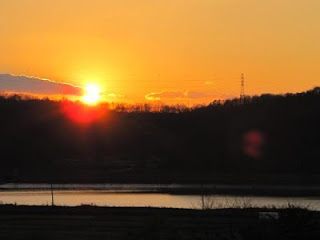I had another visit to Seoul, South Korea last week.
The city is beautiful this time of year.
 |
Photo by Mark W. Laughlin
|
The residents of Seoul have planted trees all throughout the city,
no doubt selected for their wonderful Fall colors.
 |
Photo by Mark W. Laughlin
|
There are several temples, many parks,
and ample green (well, at the moment red and yellow) spaces
planted along roadways, medians and around buildings.
But an interesting thing about Seoul, in South Korea, is its nearness to its warm, friendly, northern neighbor, North Korea. Driving north from Seoul, well before you run out of "city", you begin to see concertina wire and guard towers, continuously, along the side of the highway, which runs on either side of the river, which soon becomes part of the border between North and South.
 |
Photo by Mark W. Laughlin
|
You see, in 1953, the Korean War didn't end in the way we think of wars ending. It just "stopped", with armies pulling back, each 2 kilometers away from the Front Lines that existed when fighting ceased. And there they sit, to this day, armed, and ready to rejoin the fight if the other attacks.
 |
Photo by Mark W. Laughlin
|
The wire is there to keep out intruders from the North, intent on doing mischief, or sabotage, abductions or other harm in the South. Tensions rise from time to time, and shooting still happens.
 |
Photo by Mark W. Laughlin
|
A roadway heading into the Demilitarized Zone, now closed to all but Military traffic.
 |
Photo by Mark W. Laughlin
|
At Imjingak, a park where people come to remember family members trapped on the other side of the wire, ribbons are tied to the fence, with wishes and prayers for their return.
 |
Photo by Mark W. Laughlin
|
One reason for the open nature on the South side of the border is to keep people aware of the constant danger from the North...
By CHOE SANG-HUN, The New York Times, Published: March 26, 2010
SEOUL, South Korea — A South Korean Navy patrol ship sank near the
disputed western maritime border with North
Korea early Saturday after suffering damage to its hull, South
Korea’s military said. The sinking immediately raised suspicions
about the possible involvement of North Korea, whose navy has skirmished with
South Korean ships in the waters off the Korean Peninsula…
 |
Photo by Mark W. Laughlin
|
At Imjingak, I was no more than 50 feet behind this young gentlemen on his 24/7/365 watch. The machine gun on the stand in front of him wouldn't be there if it weren't needed...
 |
Photo by Mark W. Laughlin
|
There is limited manufacturing cooperation between North and South these days. This railroad bridge was recently rebuilt, alongside one that was destroyed in the first part of the fighting in 1951.
 |
Photo by Mark W. Laughlin
|
A nice map of the area, painted on glass, through which you look Northward, seeing the recently rebuilt bridge, and the bombed out pylons of the older one.
 |
Photo by Mark W. Laughlin
|
As you can see from this shot of our navigation system (trace the double blue line northeast from the bottom-center of the map, to the arrow at top-center-left) and you can see we were basically, "at the end of the road".
 |
Photo by Mark W. Laughlin
|
On an earlier trip, during the summer, we ventured to another place to see the border, a bit east of where we were this last time. There, a widening river forms the border. Pill-Boxes and observation posts line the Sothern side of the river. The rice fields and the "city" above have been constructed on the North side by North Korean authorities, to display to the world the idyllic living conditions in the "victorious" North. But, on close inspection with binoculars, you can see that the buildings are all fake, no glass in the windows, and no people in site.
 |
Photo by Mark W. Laughlin
|
A dull, dreary view into a dark and dangerous country.
 |
Photo by Mark W. Laughlin
|
One positive side effect of the Demilitarized Zone...it is now an undisturbed wilderness area where no one interferes with the many species of birds and other Asian wildlife living there. As you can see, these geese are not bothered by the miles (and miles) of barbed wire.
 |
Photo by Mark W. Laughlin
|
As the sun slowly sank into North Korea just over this ridge, we began our drive back to Seoul, and began seeing buildings, lights and other signs of the robust economy of South Korea, just a few miles from the "front".
 |
Photo by Mark W. Laughlin
|
Your "roving reporter"...
...Mark W. Laughlin
No comments:
Post a Comment